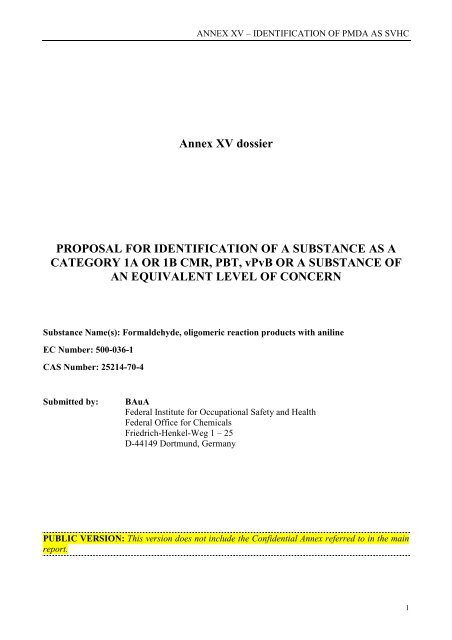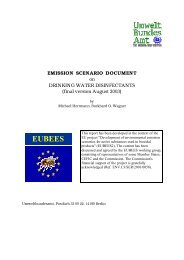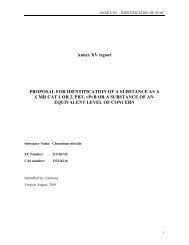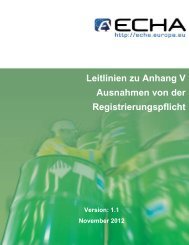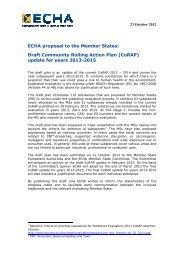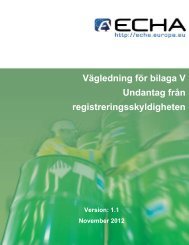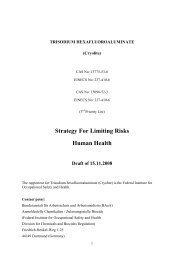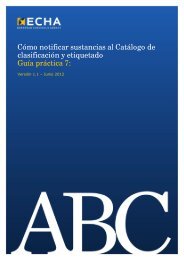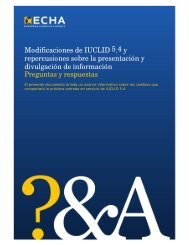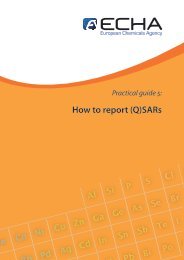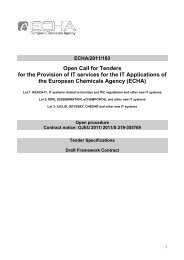Annex XV dossier PROPOSAL FOR ... - ECHA - Europa
Annex XV dossier PROPOSAL FOR ... - ECHA - Europa
Annex XV dossier PROPOSAL FOR ... - ECHA - Europa
Create successful ePaper yourself
Turn your PDF publications into a flip-book with our unique Google optimized e-Paper software.
ANNEX <strong>XV</strong> – IDENTIFICATION OF PMDA AS SVHC<br />
<strong>Annex</strong> <strong>XV</strong> <strong>dossier</strong><br />
<strong>PROPOSAL</strong> <strong>FOR</strong> IDENTIFICATION OF A SUBSTANCE AS A<br />
CATEGORY 1A OR 1B CMR, PBT, vPvB OR A SUBSTANCE OF<br />
AN EQUIVALENT LEVEL OF CONCERN<br />
Substance Name(s): Formaldehyde, oligomeric reaction products with aniline<br />
EC Number: 500-036-1<br />
CAS Number: 25214-70-4<br />
Submitted by: BAuA<br />
Federal Institute for Occupational Safety and Health<br />
Federal Office for Chemicals<br />
Friedrich-Henkel-Weg 1 – 25<br />
D-44149 Dortmund, Germany<br />
PUBLIC VERSION: This version does not include the Confidential <strong>Annex</strong> referred to in the main<br />
report.<br />
1
CONTENTS<br />
2<br />
ANNEX <strong>XV</strong> – IDENTIFICATION OF PMDA AS SVHC<br />
<strong>PROPOSAL</strong> <strong>FOR</strong> IDENTIFICATION OF A SUBSTANCE AS A CATEGORY 1A OR 1B CMR, PBT, VPVB OR A<br />
SUBSTANCE OF AN EQUIVALENT LEVEL OF CONCERN ................................................................................4<br />
PART I..........................................................................................................................................................................5<br />
JUSTIFICATION .........................................................................................................................................................5<br />
1 IDENTITY OF THE SUBSTANCE AND PHYSICAL AND CHEMICAL PROPERTIES .................................5<br />
1.1 Name and other identifiers of the substance ...................................................................................................5<br />
1.2 Composition of the substance.........................................................................................................................6<br />
1.3 Physico-chemical properties...........................................................................................................................7<br />
2 HARMONISED CLASSIFICATION AND LABELLING....................................................................................8<br />
3 ENVIRONMENTAL FATE PROPERTIES...........................................................................................................9<br />
4 HUMAN HEALTH HAZARD ASSESSMENT.....................................................................................................9<br />
5 ENVIRONMENTAL HAZARD ASSESSMENT ..................................................................................................9<br />
6 CONCLUSIONS ON THE SVHC PROPERTIES .................................................................................................9<br />
6.1 PBT, vPvB assessment ...................................................................................................................................9<br />
6.2 CMR assessment.............................................................................................................................................9<br />
6.3 Substances of equivalent level of concern assessment ...................................................................................9<br />
PART II ........................................................................................................................................................................10<br />
IN<strong>FOR</strong>MATION ON USE, EXPOSURE, ALTERNATIVES AND RISKS ...............................................................10<br />
IN<strong>FOR</strong>MATION ON MANUFACTURE, IMPORT/EXPORT AND USES –CONCLUSIONS ON EXPOSURE....10<br />
Production volumes and uses ..................................................................................................................................10<br />
Occupational exposure............................................................................................................................................12<br />
MEASURED OCCUPATIONAL EXPOSURE TO MDA (2000 -2011) IN GERMANY ..........................................12<br />
Introduction.............................................................................................................................................................12<br />
Evaluation Strategy and selection criteria...............................................................................................................13<br />
Summary of the IFA-Data.......................................................................................................................................19<br />
IN<strong>FOR</strong>MATION ON ALTERNATIVES.....................................................................................................................19<br />
Alternative substances.............................................................................................................................................19<br />
RISK-RELATED IN<strong>FOR</strong>MATION.............................................................................................................................19
ANNEX <strong>XV</strong> – IDENTIFICATION OF PMDA AS SVHC<br />
Carcinogenicity .......................................................................................................................................................19<br />
REFERENCES .............................................................................................................................................................23<br />
ABBREVIATIONS ......................................................................................................................................................24<br />
TABLES<br />
Table 1: Substance identity...........................................................................................................................................5<br />
Table 2: Generic composition (based on registration <strong>dossier</strong>s received)......................................................................6<br />
Table 3: Overview of physicochemical properties .......................................................................................................7<br />
Table 4: Classification for MDA according to part 3 of <strong>Annex</strong> VI, Table 3.1 of Regulation (EC) No 1272/2008 ......8<br />
Table 5: Classification for MDA according to part 3 of <strong>Annex</strong> VI, Table 3.2 of Regulation (EC) No 1272/2008 ......8<br />
Table 6: MDA summary on historical use volumes and relevance to authorisation [<strong>ECHA</strong>, 2008]. ...........................12<br />
Table 7: Overview Branch-Groups...............................................................................................................................14<br />
Table 8: Overview Branch-Groups – personal and static .............................................................................................15<br />
Table 9: Overview Branch-Groups with LEV ..............................................................................................................16<br />
Table 10: Overview Branch-Groups without LEV .......................................................................................................16<br />
Table 11: Work-area-group – Foundry.........................................................................................................................17<br />
Table 12: Work-area-group – Foundry – personal and static .......................................................................................17<br />
Table 13: Work-area-group – Foundry with LEV ........................................................................................................18<br />
Table 14: Work-area-group – Foundry without LEV ...................................................................................................18<br />
Table 15: RCR values calculated by the German Competent Authority for inhalation exposure scenarios of MDA ..21<br />
FIGURES<br />
Figure 1: Structural formula .........................................................................................................................................6<br />
Figure 2: Mass balance for the manufacture and use of MDA according to <strong>ECHA</strong> report [<strong>ECHA</strong>, 2008]..................11<br />
3
4<br />
ANNEX <strong>XV</strong> – IDENTIFICATION OF PMDA AS SVHC<br />
<strong>PROPOSAL</strong> <strong>FOR</strong> IDENTIFICATION OF A SUBSTANCE AS A<br />
CATEGORY 1A OR 1B CMR, PBT, VPVB OR A SUBSTANCE OF<br />
AN EQUIVALENT LEVEL OF CONCERN<br />
Substance Name(s): Formaldehyde, oligomeric reaction products with aniline<br />
EC Number: 500-036-1<br />
CAS number: 25214-70-4<br />
• The substance is proposed to be identified as substance meeting the criteria of Article 57 (a) of<br />
Regulation (EC) 1907/2006 (REACH) owing to its classification as carcinogen 1 B 1 which<br />
corresponds to classification as carcinogen category 2 2 ..<br />
Summary of how the substance(s) meet(s) the CMR (Cat 1A or 1B) criteria<br />
The structurally related substance 4,4’-diaminodiphenylmethane is listed by index number 612-051-<br />
00-1 of Regulation (EC) No 1272/2008 and classified in <strong>Annex</strong> VI, part 3, Table 3.1 (the list of<br />
harmonised classification and labelling of hazardous substances) as carcinogenic: Carc. 1B (H 350:<br />
“May cause cancer.”). The corresponding classification in <strong>Annex</strong> VI, part 3, Table 3.2 (the list of<br />
harmonised and classification and labelling of hazardous substances from <strong>Annex</strong> I to Directive<br />
67/548/EEC) of Regulation (EC) No 1272/2008 is Carc. Cat. 2; R45 (“May cause cancer.”).<br />
4,4’-diaminodiphenylmethane is a major constituent of the UVCB substance formaldehyde,<br />
oligomeric reaction products with aniline (CAS-No. 25214-70-4) and therefore the classification<br />
for 4,4’-diaminodiphenylmethane applies also for this UVCB substance. The classification of<br />
,4’-diaminodiphenylmethane in Regulation (EC) No 1272/2008 shows that also the UVCB<br />
substance formaldehyde, oligomeric reaction products with aniline meets the criteria for<br />
classification as carcinogenic in accordance with Article 57 (a) of REACH.<br />
Registration <strong>dossier</strong>s submitted for the substance? Yes<br />
1 Classification in accordance with Regulation (EC) No 1272/2008 <strong>Annex</strong> VI, part 3, Table 3.1 List of harmonised classification and<br />
labelling of hazardous substances.<br />
2 Classification in accordance with Regulation (EC) No 1272/2008, <strong>Annex</strong> VI, part 3, Table 3.2 List of harmonised classification and<br />
labelling of hazardous substances (from <strong>Annex</strong> I to Council Directive 67/548/EEC).
ANNEX <strong>XV</strong> – IDENTIFICATION OF PMDA AS SVHC<br />
PART I<br />
JUSTIFICATION<br />
1 IDENTITY OF THE SUBSTANCE AND PHYSICAL AND CHEMICAL<br />
PROPERTIES<br />
1.1 Name and other identifiers of the substance<br />
Table 1: Substance identity<br />
EC number: 500-036-1<br />
EC name: Formaldehyde, oligomeric reaction products with aniline<br />
CAS number (in the EC inventory): 25214-70-4<br />
CAS number: 25214-70-4<br />
CAS name: Formaldehyde, polymer with benzenamine<br />
IUPAC name: Formaldehyde, oligomeric reaction products with aniline<br />
Index number in <strong>Annex</strong> VI of the CLP Regulation -<br />
Molecular formula: (C6H7N.CH2O)x<br />
Molecular weight range: > 168 g/mol<br />
Synonyms:<br />
polymeric MDA 3<br />
PMDA<br />
MDA, technical grade<br />
crude MDA<br />
3 In Kirk-Othmer [1991] the substance is named polymeric MDA and this name is used in this <strong>dossier</strong> to refer to<br />
Formaldehyde, oligomeric reaction products with aniline. The name is abbreviated as PMDA.<br />
5
Structural formula:<br />
6<br />
ANNEX <strong>XV</strong> – IDENTIFICATION OF PMDA AS SVHC<br />
Figure 1: Structural formula with n = 1-5 (according to registration <strong>dossier</strong>s received) and<br />
eu = either unknown<br />
1.2 Composition of the substance<br />
Name: Formaldehyde, oligomeric reaction products with aniline<br />
Description:<br />
Degree of purity: 100%<br />
Formaldehyde, oligomeric reaction product with aniline (Technical-grade MDA) is a UVCB<br />
substance with a varying content of tri- and polynuclear amines (so-called „polymers“). A typical<br />
standard product with a content of 4,4'-MDA between ca. 47 and < 65 %(w/w) is liquid at room<br />
temperature and comprises the following:<br />
Table 2: Generic composition (based on registration <strong>dossier</strong>s received)<br />
Impurity Content range 4 % w/w CAS no. EC no. Molecular formular<br />
4,4'-MDA ca. 47 to < 65 101-77-9 202-974-4 C13H14N2<br />
2,4’-MDA < 1.4 to ca. 10 1208-52-2 214-900-8 C13H14N2<br />
2,2’-MDA ca. 0.2 to 3 6582-52-1 229-512-4 C13H14N2<br />
Higher Oligomers<br />
of MDA<br />
ca. 38.4 to < 65 - -<br />
Water < 1 7732-18-5 231-791-2 H2O<br />
(C6H7N)2<br />
Aniline < 0.1 62-53-3 200-539-3 C6H7N<br />
(CH2)(x + 1)(C6H6N)x<br />
or<br />
C(7x+13)H(6x+13)N(x+2)<br />
The separate identities indicated in the registration <strong>dossier</strong>s received are confidential and were<br />
included in the technical <strong>dossier</strong>.<br />
4 Based on registration <strong>dossier</strong>s received
1.3 Physico-chemical properties<br />
Table 3: Overview of physicochemical properties 5<br />
ANNEX <strong>XV</strong> – IDENTIFICATION OF PMDA AS SVHC<br />
Property Value Remarks<br />
Physical state at 20°C and<br />
101.3 kPa<br />
Melting/freezing point 30 — 70 °C<br />
olig. MDA is a yellow, clear,<br />
high viscous liquid/wax<br />
Boiling point 410.6 °C at 1013.25 hPa<br />
Vapour pressure < 0.000001 hPa; 20 °C<br />
0.000016 hPa; 50 °C<br />
Water solubility 0.36 g/L, Temp. 20 °C; pH 7.1 — 7.4;<br />
Partition coefficient<br />
n-octanol/water (log value)<br />
Remarks: 1 g test item per one liter of water<br />
1.22 g/L, Temp. 20 °C; pH 7.5 — 7.6<br />
Remarks: 10 g test item per one liter of water<br />
1.3 - 2.5 at 23°C/pH = 6.2<br />
1.2 -2.7 at 23°C/pH = 10<br />
Dissociation constant The test item consists of substances with a<br />
number of different amine groups. For each of<br />
these groups a discrete dissociation constant can<br />
be defined, but not determined by titration. The<br />
determination of the dissociation constant of an<br />
aqueous preparation of the test item is not<br />
possible.<br />
Key value for chemical<br />
safety assessment:<br />
Log Kow (Log Pow) 2.5,<br />
23 °C<br />
5 The references of the values reported in Table 3 will be available in the technical <strong>dossier</strong>. In case references need to be<br />
included an additional column could be added manually in Table 3.<br />
7
2 HARMONISED CLASSIFICATION AND LABELLING<br />
8<br />
ANNEX <strong>XV</strong> – IDENTIFICATION OF PMDA AS SVHC<br />
The UVCB substance formaldehyde, oligomeric reaction products with aniline is covered by the<br />
entry of 4,4’-diaminodiphenylmethane under index number 612-051-00-1 in <strong>Annex</strong> VI, Part 3 of<br />
Regulation (EC) No 1272/2008. as provided in Table 4 and Table 5.<br />
Table 4: Classification for MDA according to part 3 of <strong>Annex</strong> VI, Table 3.1 (List of<br />
harmonised classification and labelling of hazardous substances) of Regulation (EC)<br />
No 1272/2008<br />
International<br />
Chemical<br />
Identification<br />
4,4'-diaminodiphenylmethane;4,4'-methylenedianiline<br />
EC No CAS<br />
No<br />
Hazard Class<br />
and Category<br />
Code(s)<br />
202-974-4 101-77-9 Carc. 1B<br />
Muta. 2<br />
STOT SE 1<br />
STOT RE 2 *<br />
Skin Sens. 1<br />
Aquatic Chronic<br />
2<br />
Classification Labelling<br />
Hazard<br />
Statement<br />
Code(s)<br />
H350<br />
H341<br />
H370 **<br />
H373 **<br />
H317<br />
H411<br />
Pictogram,<br />
Signal Word<br />
Code(s)<br />
GHS08<br />
GHS07<br />
GHS09<br />
Dgr<br />
Hazard<br />
statement<br />
Code(s)<br />
H350<br />
H341<br />
H370 **<br />
H373 **<br />
H317<br />
H411<br />
Suppl.<br />
Hazard<br />
statement<br />
Code(s)<br />
Specific<br />
Conc.<br />
Limits,<br />
M-factors<br />
Table 5: Classification for MDA according to part 3 of <strong>Annex</strong> VI, Table 3.2 (list of<br />
harmonised classification and labelling of hazardous substances from <strong>Annex</strong> I of<br />
Council Directive 67/548/EEC) of Regulation (EC) No 1272/2008<br />
Index No Chemical name Notes<br />
related to<br />
substances<br />
ANNEX 1<br />
612-051-00-1 4,4'-diaminodiphenylmethane;4,4'-methylenedianiline<br />
EC No CAS No Classification Labelling Concentration<br />
Limits<br />
202-974-4 101-77-9 Carc. Cat. 2; R45<br />
Muta. Cat. 3; R68<br />
T; R39/23/24/25<br />
Xn; R48/20/21/22<br />
R43<br />
N; R51-53<br />
R: 45-<br />
39/23/24/2<br />
5-43-<br />
48/20/21/2<br />
2-68-51/53<br />
S: 53-45-<br />
61<br />
Notes<br />
Notes related<br />
to<br />
preparations
3 ENVIRONMENTAL FATE PROPERTIES<br />
Not relevant.<br />
4 HUMAN HEALTH HAZARD ASSESSMENT<br />
See section 2 on harmonised classification and labelling.<br />
5 ENVIRONMENTAL HAZARD ASSESSMENT<br />
Not relevant.<br />
6 CONCLUSIONS ON THE SVHC PROPERTIES<br />
6.1 PBT, vPvB assessment<br />
Not relevant<br />
6.2 CMR assessment<br />
ANNEX <strong>XV</strong> – IDENTIFICATION OF PMDA AS SVHC<br />
The structurally related substance 4,4’-diaminodiphenylmethane is listed by index number<br />
612-051-00-1 of Regulation (EC) No 1272/2008 and classified in <strong>Annex</strong> VI, part 3, Table 3.1<br />
(the list of harmonised classification and labelling of hazardous substances) as carcinogenic:<br />
Carc. 1B (H 350: “May cause cancer.”). The corresponding classification in <strong>Annex</strong> VI, part 3,<br />
Table 3.2 (the list of harmonised and classification and labelling of hazardous substances<br />
from <strong>Annex</strong> I to Directive 67/548/EEC) of Regulation (EC) No 1272/2008 is Carc. Cat. 2;<br />
R45 (“May cause cancer.”).<br />
4,4’-diaminodiphenylmethane is a major constituent of the UVCB substance formaldehyde,<br />
oligomeric reaction products with aniline (CAS-No. 25214-70-4) and therefore the<br />
classification for 4,4’-diaminodiphenylmethane applies also for this UVCB substance. The<br />
classification of ,4’-diaminodiphenylmethane in Regulation (EC) No 1272/2008 shows that<br />
also the UVCB substance formaldehyde, oligomeric reaction products with aniline meets the<br />
criteria for classification as carcinogenic in accordance with Article 57 (a) of REACH.<br />
6.3 Substances of equivalent level of concern assessment<br />
Not relevant<br />
9
10<br />
ANNEX <strong>XV</strong> – IDENTIFICATION OF PMDA AS SVHC<br />
PART II<br />
IN<strong>FOR</strong>MATION ON USE, EXPOSURE, ALTERNATIVES AND<br />
RISKS<br />
IN<strong>FOR</strong>MATION ON MANUFACTURE, IMPORT/EXPORT AND USES –<br />
CONCLUSIONS ON EXPOSURE<br />
Production volumes and uses<br />
Registration information on production volumes and uses is provided in the confidential<br />
<strong>Annex</strong> to this report. Further background information on production volumes and uses is<br />
taken from the <strong>ECHA</strong> Report “Data on manufacture, import, export, uses and releases of 4,4’diaminophenylmethane<br />
(MDA) as well as information on potential alternatives to its use”<br />
[<strong>ECHA</strong>, 2008]. It has to be noted that the <strong>ECHA</strong> report only refers to 4,4’diaminophenylmethane<br />
(MDA). Nevertheless the production volumes of MDA and PMDA<br />
correspond approximately because the manufacturing process of PMDA and MDA are<br />
essentially identical, with the exception of a separation step [Kirk-Othmer, 1991]. Therefore,<br />
the production volumes given in the <strong>ECHA</strong> report apply for PMDA as well.<br />
Manufacture and use for MDI<br />
PMDA is synthesized by reaction of formaldehyde and aniline in the presence of hydrochloric<br />
acid. All processes produce polymeric MDA (PMDA), which consists of mixtures of isomers<br />
and oligomers of MDA. As 98% of PMDA is used as a precursor to methylene diphenyldiisocyanate<br />
(MDI), the production tonnage of PMDA has been calculated, from the<br />
production tonnage of MDI, to be in the region of 1400000 t in 2008.<br />
Other uses<br />
Other uses of PMDA are:<br />
• as a hardener for epoxy resins in<br />
• adhesives,<br />
• production of rolls with composite cover,<br />
• production of chemically resistant pipes<br />
• production of moulds,<br />
• in the production of high performance polymers and<br />
• as a starting point for the synthesis of 4,4’-methylenebis(cyclohexaneamine)<br />
(PACM).<br />
Tonnages involved in use of PMDA as a hardener in epoxy resins are confidential (see<br />
<strong>Annex</strong> III of <strong>ECHA</strong> Report [2008]) and are unknown for adhesives. The overall EU<br />
consumption for use as a hardener in epoxy resins is estimated by one company to be around<br />
200 t, however further confidential information suggests that this figure may be regarded as a
ANNEX <strong>XV</strong> – IDENTIFICATION OF PMDA AS SVHC<br />
minimum. A number of applications for the use of PMDA as a hardener in adhesives are<br />
understood to have been phased out. A producer of high performance polymer using PMDA<br />
as a raw material indicated using less than 5000 tpa at a single site. No information on the<br />
tonnages involved in the manufacture of PACM has been made available, although PACM is<br />
produced in the EU. A summary of uses and indicative volumes for each use based on<br />
information gathered for the <strong>ECHA</strong> study [<strong>ECHA</strong>, 2008] is presented below.<br />
Figure 2: Mass balance for the manufacture and use of MDA according to <strong>ECHA</strong><br />
report [<strong>ECHA</strong>, 2008]<br />
11
12<br />
ANNEX <strong>XV</strong> – IDENTIFICATION OF PMDA AS SVHC<br />
Table 6: Summary on historical use volumes of MDA and relevance to authorisation<br />
[<strong>ECHA</strong>, 2008].<br />
Occupational exposure<br />
As previously stated is it very difficult to treat MDA as a single entity because the<br />
manufacturing processes of PMDA and MDA are essentially identical, with the exception of a<br />
separation step. Therefore the exposure assessment below either relates to MDA as a<br />
component of PMDA or to pure MDA where necessary.<br />
Occupational exposure scenarios in the chemical industry and industrial area and in skilled<br />
trade have been considered. The exposure assessment is based on measured data from IFA-<br />
Institute for Occupational Safety and Health of the German Social Accident Insurance.<br />
(limited), expert judgement and the ECETOC TRA worker tool (Version 2).<br />
Since occupational exposure scenarios in the chemical industry and industrial area are taken<br />
from the Chemical Safety Report this information can be found in the confidential <strong>Annex</strong>.<br />
Although the registration information indicates that PMDA is intended to be used only in an<br />
industrial setting, a skilled trade scenario has also been included in the modelled exposure<br />
assessment. This was done to illustrate that professional use of PMDA must be excluded in<br />
any case.<br />
MEASURED OCCUPATIONAL EXPOSURE TO MDA (2000 -2011) IN GERMANY<br />
Introduction<br />
The German worker exposure data were provided by the IFA-Institute for Occupational<br />
Safety and Health of the German Social Accident Insurance.<br />
The new data provided by the IFA were measured in industry for the years 2000 to 2011. The<br />
data are differentiated into personal sampling data taken while the individual was carrying out
ANNEX <strong>XV</strong> – IDENTIFICATION OF PMDA AS SVHC<br />
all activities, i.e. active plant work, control room work and break periods and data from static<br />
sampling in the different workplaces.<br />
The identification and documentation of the following evaluated data from exposures in the<br />
workplace are based on the criteria of the MGU (Messsystem Gefährdungsermittlung der<br />
Unfallversicherungsträger - measuring hazard identification of accident insurance carrier<br />
(formerly BGMG)) [Gabriel, S. et al., 2010]. The standard of the MGU is a quality<br />
management system, which essentially implements the requirements of DIN EN ISO 9001.<br />
The testing laboratories are operated in accordance with DIN EN ISO 17025.<br />
All data collected will be merged into the exposure database MEGA (measurement data to<br />
exposure to hazardous substances at work). The MEGA exposure database is maintained and<br />
evaluated for the institutions for statutory accident insurance and prevention by Institute for<br />
Occupational Safety and Health of the German Social Accident Insurance (IFA, formerly<br />
BGIA; German: Institut für Arbeitsschutz der Deutschen Gesetzlichen Unfallversicherung).<br />
If individual measurements are below the limit of quantification (LOQ) of the applied<br />
analytical method, half of this value is taken into account within the statistical evaluation. The<br />
MEGAPRO software, developed by IFA, allows the statistical analysis of the data of the<br />
exposure database MEGA according to different selection criteria and evaluation strategies.<br />
Evaluation Strategy and selection criteria<br />
Table 7 – Table 14 show the evaluated German worker exposure data (expressed as MDA)<br />
collected in the years 2000-2011.<br />
The evaluation is made in the form of industry (branch groups) and work area groups and<br />
further differentiated by the sampling strategy (static or on the person) and the presence of a<br />
LEV (Local Exhaust Ventilation). A general overview of the branch groups, which are in<br />
correlation to the main uses mentioned at the beginning of chapter “Information on<br />
Manufacture and uses” is given in Table 7 to Table 10.<br />
A deeper analysis of the exposure of workers in the main work area group (foundry)<br />
representing more than 57% of the whole data collective, separated into exposure relevant<br />
processes, is considered separately in the same way in the Table 11 to Table 14.<br />
13
Table 7: Overview Branch-Groups<br />
Groups Type Number of<br />
samples<br />
14<br />
Enterprises Frequency of<br />
samples <<br />
LOQ<br />
Total all 86 36 78<br />
(90.7 %)<br />
Plastic and foam<br />
material,<br />
processing,<br />
production<br />
Steel foundry,<br />
mixed steel foundry<br />
all 13 6 12<br />
(92.3 %)<br />
all 47 18 43<br />
(91.5 %)<br />
Number<br />
UVT<br />
Limit of<br />
quantification<br />
(mg/m³)<br />
ANNEX <strong>XV</strong> – IDENTIFICATION OF PMDA AS SVHC<br />
50th-perc.<br />
(mg/m³)<br />
75th-perc.<br />
(mg/m³)<br />
90th-perc.<br />
(mg/m³)<br />
95th-perc.<br />
(mg/m³)<br />
8 0.006 LOQ (!) LOQ (!) LOQ (!) 0.0035 (+)<br />
4 0.002 LOQ (!) LOQ (!) LOQ (!) 0.001 (+)<br />
2 0.006 LOQ (!) LOQ (!) LOQ (!) 0.0073 (+)<br />
Within the evaluation tables the following abbreviations and indexes are used:<br />
LOQ Limit of quantification<br />
(!) The specification of a cumulative frequency concentration in the results table is not made, as there are more measurement values below the analytical limit of quantification (LOQ) , as<br />
measurement values are represented by this cumulative frequency value<br />
(+) Distribution value is below the largest limit of quantification (LOQ) of the data collective.<br />
Perc. Percentile
Table 8: Overview Branch-Groups – personal and static<br />
Groups Type Number of<br />
samples<br />
Enterprises Frequency of<br />
samples <<br />
LOQ<br />
Total personal 28 16 24<br />
(85.7 %)<br />
Plastic and foam<br />
material,<br />
processing,<br />
production<br />
Steel foundry,<br />
mixed steel foundry<br />
static 58 28 54<br />
(93.1 %)<br />
personal 2 1 2<br />
(100 %)<br />
static 11 5 10<br />
(90.9 %)<br />
personal 16 8 13<br />
(81.3 %)<br />
static 31 14 30<br />
(96.8 %)<br />
Number<br />
UVT<br />
Limit of<br />
quantification<br />
(mg/m³)<br />
ANNEX <strong>XV</strong> – IDENTIFICATION OF PMDA AS SVHC<br />
50th-perc.<br />
(mg/m³)<br />
75th-perc.<br />
(mg/m³)<br />
90th-perc.<br />
(mg/m³)<br />
95th-perc.<br />
(mg/m³)<br />
5 0.006 LOQ (!) LOQ (!) 0.0036 (+) 0.0072<br />
8 0.005 LOQ (!) LOQ (!) LOQ (!) 0.0025 (+)<br />
1 0.002<br />
4 0.002 LOQ (!) LOQ (!) LOQ (!) 0.001 (+)<br />
2 0.006 LOQ (!) LOQ (!) 0.0068 0.0524<br />
2 0.005 LOQ (!) LOQ (!) LOQ (!) LOQ (!)<br />
15
Table 9: Overview Branch-Groups with LEV<br />
Groups Type Number of<br />
samples<br />
16<br />
Enterprises Frequency of<br />
samples <<br />
LOQ<br />
Total all 52 21 46<br />
(88.5 %)<br />
Plastic and foam<br />
material,<br />
processing,<br />
production<br />
Steel foundry,<br />
mixed steel foundry<br />
all 8 2 8<br />
(100 %)<br />
all 21 9 18<br />
(85.7 %)<br />
Table 10: Overview Branch-Groups without LEV<br />
Groups Type Number of<br />
samples<br />
Enterprises Frequency of<br />
samples <<br />
LOQ<br />
Total all 26 14 24<br />
(92.3 %)<br />
Plastic and foam<br />
material,<br />
processing,<br />
production<br />
Steel foundry,<br />
mixed steel foundry<br />
all 4 3 3<br />
(75 %)<br />
all 21 10 20<br />
(95.2 %)<br />
Number<br />
UVT<br />
Limit of<br />
quantification<br />
(mg/m³)<br />
ANNEX <strong>XV</strong> – IDENTIFICATION OF PMDA AS SVHC<br />
50th-perc.<br />
(mg/m³)<br />
75th-perc.<br />
(mg/m³)<br />
90th-perc.<br />
(mg/m³)<br />
95th-perc.<br />
(mg/m³)<br />
7 0.006 LOQ (!) LOQ (!) 0.0025 (+) 0.0054(+)<br />
2 0.002<br />
2 0.006 LOQ (!) LOQ (!) 0.0075 0.0413<br />
Number<br />
UVT<br />
Limit of<br />
quantification<br />
(mg/m³)<br />
50th-perc.<br />
(mg/m³)<br />
75th-perc.<br />
(mg/m³)<br />
90th-perc.<br />
(mg/m³)<br />
95th-perc.<br />
(mg/m³)<br />
4 0.005 LOQ (!) LOQ (!) LOQ (!) 0.0025 (+)<br />
3 0.001<br />
1 0.005 LOQ (!) LOQ (!) LOQ (!) LOQ (!)
Table 11: Work-area-group – Foundry<br />
Groups Type Number of<br />
samples<br />
Enterprises Frequency of<br />
samples <<br />
LOQ<br />
Moulding-area All 14 3 13<br />
(92.9 %)<br />
Foundry All 23 11 20<br />
(87 %)<br />
Mixing All 11 3 8<br />
(72.7 %)<br />
Table 12: Work-area-group – Foundry – personal and static<br />
Groups Type Number of<br />
samples<br />
Enterprises Frequency of<br />
samples <<br />
LOQ<br />
Moulding-area personal 3 1 3<br />
(100 %)<br />
static 11 3 10<br />
(90.9 %)<br />
Foundry personal 9 5 6<br />
(66.7 %)<br />
static 14 9 14<br />
(100 %)<br />
Mixing personal 1 1 0 1<br />
static 10 2 8<br />
(80 %)<br />
Number<br />
UVT<br />
Limit of<br />
quantification<br />
(mg/m³)<br />
ANNEX <strong>XV</strong> – IDENTIFICATION OF PMDA AS SVHC<br />
50th-perc.<br />
(mg/m³)<br />
75th-perc.<br />
(mg/m³)<br />
90th-perc.<br />
(mg/m³)<br />
95th-perc.<br />
(mg/m³)<br />
1 0.006 LOQ (!) LOQ (!) LOQ (!) 0.015<br />
1 0.005 LOQ (!)<br />
LOQ (!)<br />
0.005 (+) 0.0077<br />
3 0.002 LOQ (!) 0.001 (+) 0.002 (+) 0.003<br />
Number<br />
UVT<br />
1 0.006<br />
Limit of<br />
quantification<br />
(mg/m³)<br />
50th-perc.<br />
(mg/m³)<br />
75th-perc.<br />
(mg/m³)<br />
90th-perc.<br />
(mg/m³)<br />
95th-perc.<br />
(mg/m³)<br />
1 0.005 LOQ (!) LOQ (!) LOQ (!) 0.0207<br />
1 0.005<br />
1 0.005 LOQ (!) LOQ (!) LOQ (!) LOQ (!)<br />
2 0.002 LOQ (!) LOQ (!) 0.002 (+) 0.003<br />
17
Table 13: Work-area-group – Foundry with LEV<br />
Groups Type Number of<br />
samples<br />
18<br />
Enterprises Frequency of<br />
samples <<br />
LOQ<br />
Moulding-area All 11 1 10<br />
(90.9 %)<br />
Foundry All 5 4 3<br />
(60 %)<br />
Mixing All 11 3 8<br />
(72.7 %)<br />
Table 14: Work-area-group – Foundry without LEV<br />
Groups Type Number of<br />
samples<br />
Enterprises Frequency of<br />
samples <<br />
LOQ<br />
Moulding-area All 3 2 3<br />
(100 %)<br />
Cast-process All 16 9 15<br />
(93.8 %)<br />
Mixing All 0 0 0 0<br />
Number<br />
UVT<br />
Limit of<br />
quantification<br />
(mg/m³)<br />
ANNEX <strong>XV</strong> – IDENTIFICATION OF PMDA AS SVHC<br />
50th-perc.<br />
(mg/m³)<br />
75th-perc.<br />
(mg/m³)<br />
90th-perc.<br />
(mg/m³)<br />
95th-perc.<br />
(mg/m³)<br />
1 0.006 LOQ (!) LOQ (!) LOQ (!) 0.021<br />
1 0.005<br />
3 0.002 LOQ (!) 0.001 (+) 0.002 (+) 0.003<br />
Number<br />
UVT<br />
1 0.005<br />
Limit of<br />
quantification<br />
(mg/m³)<br />
50th-perc.<br />
(mg/m³)<br />
1 0.005 LOQ (!)<br />
75th-perc.<br />
(mg/m³)<br />
LOQ (!)<br />
90th-perc.<br />
(mg/m³)<br />
LOQ (!)<br />
95th-perc.<br />
(mg/m³)<br />
0.005 (+)
Summary of the IFA-Data<br />
ANNEX <strong>XV</strong> – IDENTIFICATION OF PMDA AS SVHC<br />
The data presented above reveal that airborne concentrations of MDA in the area of plastic<br />
and foam material processing and production are below the analytical limit of quantification<br />
(LOQ). Relevant airborne concentrations of MDA have only been observed in the branch<br />
group of steel foundry. The overall statistics for the steel foundry area (Table 8) estimates the<br />
95 th percentile to 0,0524 mg/m 3 (90 th percentile 0,0068 mg/m 3 ) in case of personal sampling.<br />
Although the number of personal samples are quite small (n = 16) the IFA data reveal that<br />
inhalation exposure to MDA may occur in the steel foundry area.<br />
IN<strong>FOR</strong>MATION ON ALTERNATIVES<br />
Alternative substances<br />
For alternatives for the uses that could be subject to authorisation (i.e. when MDA is<br />
considered not to be an intermediate), reference is made to [<strong>ECHA</strong>, 2008]. It is understood<br />
that other aromatic amines or aliphatic amines can be used as alternatives as curing agents in<br />
some circumstances although information on alternatives for specific applications has not<br />
been found.<br />
Based on the literature review undertaken in [<strong>ECHA</strong>, 2008], it has not been possible to gain a<br />
good overview of the current status of development of alternatives for the remaining non-MDI<br />
uses (particularly as hardener in epoxy resins and adhesives). Some promising alternatives<br />
have obviously been identified (as evidenced by a number of patents), though the actual<br />
market suitability of these alternatives is unknown.<br />
RISK-RELATED IN<strong>FOR</strong>MATION<br />
Risk related information for MDA is taken from the exposure-risk-relationship (ERB),<br />
published by the German Committee on Hazardous Substances (AGS) (AGS, 2010). The<br />
information from the ERB is reduced in this <strong>Annex</strong> <strong>XV</strong> document to the most critical<br />
endpoint, the carcinogenicity after inhalation and dermal contact. In the table below, all<br />
exposure scenarios are listed and compared with the calculated acceptance risk (4:10000). The<br />
quotient of exposure and acceptance risk is expressed as Risk Characterisation Ratio (RCR)<br />
and is calculated by the German Competent Authority. An RCR < 1 implicates an acceptable<br />
risk whereas an RCR > 1 is associated with an unacceptable risk.<br />
Carcinogenicity<br />
The following clause summarises the relevant parts of the ERB for MDA which was<br />
announced by the AGS in 2010 [AGS, 2010] and shows the German approach in terms of<br />
calculating risk estimates for carcinogenic substances at the workplace.<br />
As starting point for deducing the exposure-risk-relationship the chronic NTP studies are<br />
chosen in which MDA hydrochloride was administered by drinking water to F344 rats and<br />
B6C3F1 mice. The most sensitive carcinogenic effects observed in these studies are neoplastic<br />
nodes as well as carcinomas in the liver of male rats [Weisburger et al., 1984, Lamb et al.,<br />
1986]. According to the AGS concept [AGS, 2008] and the below mentioned formula a T25<br />
Page 19 of 24
ANNEX <strong>XV</strong> – IDENTIFICATION OF PMDA AS SVHC<br />
is calculated based on the summarised incidences of carcinogenic liver effects in the male rat.<br />
This results in an hT25 of 45.7 mg/m 3 .<br />
reference incidence<br />
( 1 − control incidence)<br />
hT 25 = C ⋅<br />
⋅<br />
( incidence at significance<br />
− control incidence)<br />
1<br />
With C: lowest concentration with a significant carcinogenic effect: 44.8 mg/m 3<br />
Reference incidence: 0.25<br />
Incidence at significance: 0.26 (12/50)<br />
Control incidence: 0.02 (1/50)<br />
The mechanism of carcinogenicity of MDA is still not clarified. Genotoxic mechanism as<br />
well as non-genotoxic mechanism could be assumed. It is supposed that reactive metabolites<br />
of MDA directly interact with the DNA of the target organ. Therefore, the AGS<br />
conservatively decided to assume a genotoxic mode of action for the carcinogenicity of MDA.<br />
Consequently a linear extrapolation to the low dose is carried out. From these considerations<br />
the exposure-risk-relationship for MDA results in following nominal excess risks:<br />
Tolerance risk (4:1000) 731 µg/m 3<br />
Acceptance risk (4:10000) 73 µg/m 3<br />
Acceptance risk (4:100000) after 2013 at the latest 2018 7.3 µg/m 3<br />
Within the process of registration two derived minimum effect levels (DMELs) are calculated.<br />
The values are: DMELdermal 0.004 mg/kg/d and DMELinhalation 0.014 mg/m 3 (<strong>ECHA</strong> website,<br />
22.08.2011). These DMELs are consistent with the above mentioned nominal excess risks<br />
determined by the AGS [AGS, 2010].<br />
To have an overview the RCRs are calculated by the German Competent Authority with the<br />
according DMEL as well as with the acceptance risk (see Table 15 and confidential annex).<br />
Inhalation<br />
No modification of the acceptance risk (4:10000) is necessary as this nominal risk is relevant<br />
to humans. The required extrapolation for workplace time, respiratory volume, higher<br />
sensitivity of humans, and route-to-route was carried out within the ERB.<br />
No modification of the DMELinhalation is necessary as this value is relevant to humans.<br />
As the evaluation of the IFA-data shows inhalation exposure to workers, the RCR for purpose<br />
of carcinogenic risk assessment is calculated by the German Competent Authority (see<br />
Table 15). The RCR express the quotient of exposure (IFA-data) and acceptance risk or<br />
DMEL and implicates an acceptable risk if the value is < 1.<br />
Page 20 of 24
ANNEX <strong>XV</strong> – IDENTIFICATION OF PMDA AS SVHC<br />
Table 15: RCR values calculated by the German Competent Authority for inhalation exposure scenarios of MDA taken from the IFAdata<br />
Groups<br />
95 th -perc.<br />
[mg/m 3 ]<br />
traffic light model DMEL-concept<br />
acceptance risk<br />
[mg/m 3 ]<br />
Page 21 of 24<br />
RCR acceptance<br />
risk<br />
DMEL<br />
[mg/m 3 ]<br />
RCR DMEL<br />
overview branch-groups (see Table 7)<br />
total 0.0035 (+) 0.07 0.05 0.014 0.25<br />
plastic and foam material, processing, production 0.001 (+) 0.07 0.01 0.014 0.07<br />
steel foundry, mixed steel foundry 0.0073 (+) 0.07 0.10 0.014 0.52<br />
overview branch-groups – personal and static (see Table 8)<br />
total (personal) 0.0072 0.07 0.10 0.014 0.51<br />
total (static) 0.0025 (+) 0.07 0.04 0.014 0.18<br />
plastic and foam material, processing, production (static) 0.001 (+) 0.07 0.01 0.014 0.07<br />
steel foundry, mixed steel foundry (personal) 0.0524 0.07 0.75 0.014 3.74<br />
overview branch-groups with LEV (see Table 9)<br />
total 0.0054 (+) 0.07 0.08 0.014 0.39<br />
steel foundry, mixed steel foundry 0.0413 0.07 0.59 0.014 2.95<br />
overview branch-groups without LEV (see Table 10)<br />
total 0.0025 (+) 0.07 0.04 0.014 0.18<br />
work-area-group – foundry (see Table 11)<br />
moulding area 0.015 0.07 0.21 0.014 1.07<br />
foundry 0.0077 0.07 0.11 0.014 0.55<br />
mixing 0.003 0.07 0.04 0.014 0.21<br />
work-area-group – foundry – personal and static (see Table 12)<br />
moulding-area (static) 0.0207 0.07 0.30 0.014 1.48<br />
mixing (static) 0.003 0.07 0.04 0.014 0.21<br />
work-area-group – foundry with LEV (see Table 13)<br />
moulding-area 0.021 0.07 0.30 0.014 1.50<br />
mixing 0.003 0.07 0.04 0.014 0.21<br />
work-area-group – foundry without LEV (see Table 14)<br />
cast-process 0.005 (+) 0.07 0.07 0.014 0.36<br />
(+): Distribution value is below the largest limit of quantification (LOQ) of the data collective
ANNEX <strong>XV</strong> – IDENTIFICATION OF PMDA AS SVHC<br />
While the given data provided by the IFA may not contradict the safe use of PMDA in<br />
industry as indicated by the registration <strong>dossier</strong>s, they clearly allocate that inhalation exposure<br />
to MDA does arise even under relatively controlled conditions as in industrial settings. All<br />
RCR calculated by the German Competent Authority with the acceptance risk (0.07 mg/m 3 )<br />
show values below 1 and therefore an acceptable risk level. The column with RCRs calculated<br />
with DMELinhalation (0.014 mg/m 3 ) shows four values > 1 and one borderline scenario. It has to<br />
be mentioned that the current acceptance risk will be lowered at the latest in 2018 to<br />
0.007 mg/m 3 , thus being in the same range as the DMEL inhalation.<br />
Dermal<br />
The acceptance risk (4:10000) of 0.07 mg/m 3 is extrapolated to a modified value assumed to<br />
be relevant to humans (dermal exposure) by the following steps. The implication of a<br />
respiratory volume (10 m 3 ) and a body weight of 70 kg results in a modified acceptance risk<br />
(4:10000) for dermal exposure of 10 µg/kg/d.<br />
No modification of the DMEL dermal is necessary as this value is relevant to humans.<br />
The RCR for all dermal exposure scenarios are calculated by the German Competent<br />
Authority, for details see confidential <strong>Annex</strong>.<br />
Some of the calculated RCR-values are very high resulting in high concern for<br />
carcinogenicity due to dermal contact.<br />
Page 22 of 24
ANNEX <strong>XV</strong> – IDENTIFICATION OF PMDA AS SVHC<br />
REFERENCES<br />
AGS (2008), German Committee on Hazardous Substances: Guide for the quantification of cancer<br />
risk figures after exposure to carcinogenic hazardous substances for establishing limit values at the<br />
workplace.<br />
http://www.baua.de/en/Publications/Expert-Papers/Gd34.pdf?__blob=publicationFile&v=5<br />
AGS (2010), German Committee on Hazardous Substances: Begründung zu Expositions-Risiko-<br />
Beziehung 4,4’Methylendianilin in BekGS 910<br />
http://www.baua.de/de/Themen-von-A-Z/Gefahrstoffe/TRGS/pdf/910/910-4-4-methylendianilin.pdf?__blob=publicationFile&v=2<br />
Chemical Safety Report for Formaldehyde, oligomeric reaction products with aniline, 2010-11-16<br />
CSR-PI-5.2.1.<br />
<strong>ECHA</strong> report (2008): Data on manufacture, import, export, uses and releases of<br />
4,4’-diaminodiphenylmethane as well as information on potential alternatives to its use (specific<br />
contract <strong>ECHA</strong>/2008/02/SR5/ECA.227).<br />
<strong>ECHA</strong> website, 22.08.2011: http://apps.echa.europa.eu/registered/data/<strong>dossier</strong>s/DISS-9d99d110-026b-3a79-e044-<br />
00144f67d249/AGGR-5f11a3d8-0a0f-4285-9924-40641866f705_DISS-9d99d110-026b-3a79-e044-<br />
00144f67d249.html#AGGR-5f11a3d8-0a0f-4285-9924-40641866f705<br />
Gabriel, S.; Koppisch, D. and Range, D. (2010): The MGU – a monitoring system for the collection<br />
and documentation of valid workplace exposure data. Gefahrstoffe - Reinhalt. Luft 70 Nr. 1/2, S.<br />
43-49.<br />
http://www.dguv.de/ifa/de/pub/grl/pdf/2010_002.pdf<br />
Kirk-Othmer (Edt.,1991): Encyclopedia of Chemical Technology, Vol. 2, 4th Ed., New York, John<br />
Wiley, pp. 461–473.<br />
Lamb, J.C., Huff, J.E., Haseman, J.K., Murthy, A.S., Lilja, H. (1986): Carcinogenesis studies of<br />
4,4’-methylenedianiline dihydrochloride given in drinking water to F344/N rats and B6C3F1 mice.<br />
Journal of Toxicology and Environmental Health 18; 325-337; cited from ECB, 2001<br />
TNsG (2007): Technical Notes for Guidance on Human Exposure to Biocidal Products, p.19<br />
http://ihcp.jrc.ec.europa.eu/our_activities/healthenv/risk_assessment_of_Biocides/doc/TNsG/TNsG_ON_HUMAN_EXPOSURE/TNsG%20-Human-Exposure-<br />
2007.pdf<br />
Weisburger, E.K., Murthy, A.S., Lilja, H.S., Lamb, J.C. (1984): Neoplastic response of F344 rats<br />
and B6C3F1 mice to the polymer and dyestuff intermediates 4,4’-methylenebis(N,N-dimethyl)benzenamine,<br />
4,4’-oxydianiline, and 4,4’-methylenedianiline. Journal of the National Cancer<br />
Institute 72, 1457-1463; cited from ECB, 2001<br />
Page 23 of 24
ANNEX <strong>XV</strong> – IDENTIFICATION OF PMDA AS SVHC<br />
ABBREVIATIONS<br />
AGS German Committee on Hazardous Substances<br />
CSR chemical safety report<br />
DMEL derived minimal effect level<br />
ECB (Ex-)European Chemicals Bureau.<br />
ERB exposure-risk-relationship<br />
ES exposure scenario<br />
hT25 human equivalent T25<br />
IFA Institute for Occupational Safety and Health of the German Social Accident<br />
Insurance<br />
IFA formerly BGIA; German: Institut für Arbeitsschutz der Deutschen<br />
Gesetzlichen Unfallversicherung<br />
LEV local exhaust ventilation<br />
LOQ limit of quantification<br />
MGU measuring hazard identification of accident insurance carrier (Messsystem<br />
Gefährdungsermittlung der Unfallversicherungsträger - (formerly BGMG)<br />
PACM 4,4’-methylenebis(cyclohexaneamine)<br />
PPE personal protection pquipment<br />
RCR risk characterisation ratio<br />
T25 tumourigenic dose at which 25 % additional incidence is expected<br />
tpa tons per anno<br />
UVCB substances substances of unknown or, variable, complex composition or biological<br />
origin<br />
UVT accident insurance carrier (Unfallversicherungsträger)<br />
Page 24 of 24


